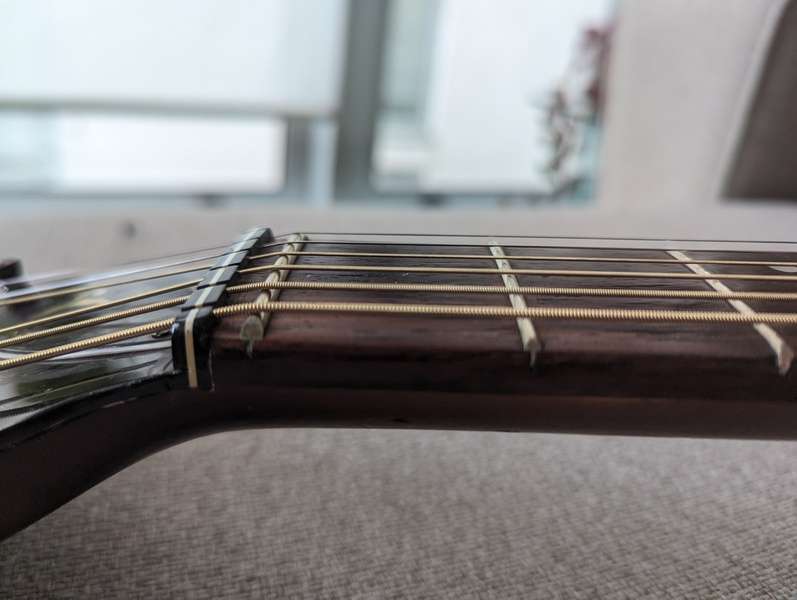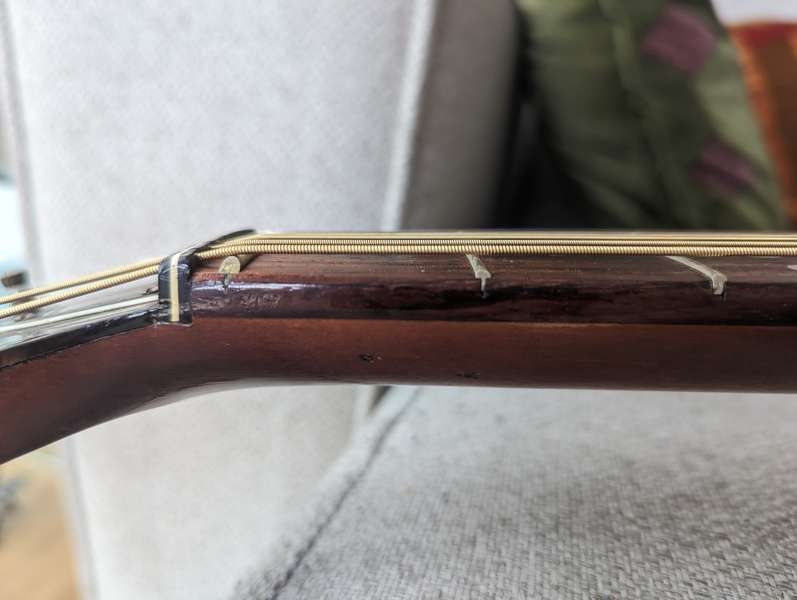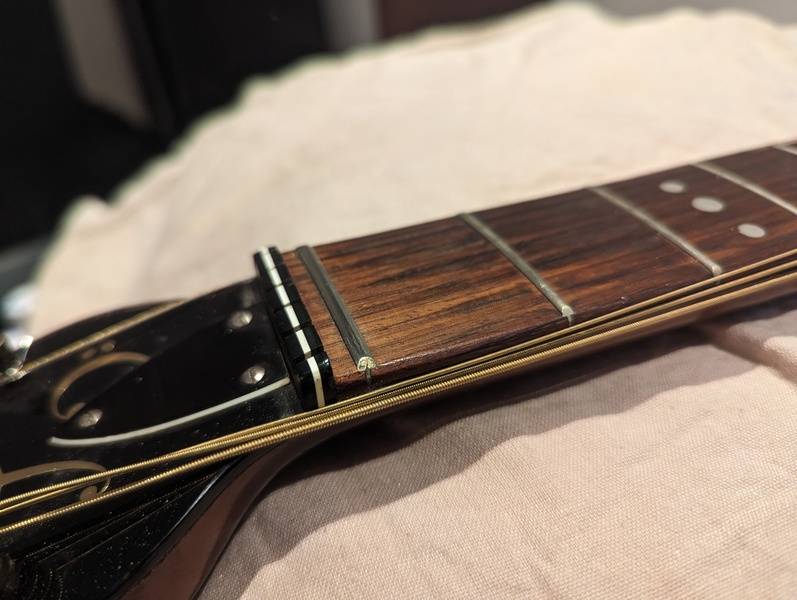
-
Hello everyone,
I'm excited to share that I've recently acquired my first acoustic archtop, a 1960 Hofner Senator, which also happens to be my first guitar with a zero fret.
However, upon closer inspection, I've noticed that the zero fret on this guitar is noticeably thicker and taller than all the other frets. My understanding was that zero frets are typically uniform in size and height compared to the rest of the frets.
Now, I'm wondering if there's something I'm overlooking here or if perhaps the frets on this guitar were modified incorrectly at some point in its history.
Despite setting the action at the 12th fret correctly (around 2.5mm) and ensuring the neck is nearly straight, I'm unable to lower the action at the first fret beyond approximately 1mm (0.04"). Ideally, I'd like to achieve a lower action, around 0.5mm, but the oversized zero fret seems to be hindering this adjustment.
Could someone clarify whether this discrepancy is standard, and if not, what would be the best course of action? Should I consider replacing the fret altogether, or would sanding it down suffice?
Any insights or advice would be greatly appreciated. Thank you!



-
-
Zero frets are typically a bit bigger/taller than the rest of the frets to make it easier to set the action in a factory production environment. Just sand it down to a height that works for you.
-
I've had three guitars with a zero fret. After a while it gets dented and it doesn't work properly, the strings get stuck when you bend, or the action gets uneven. I would replace it with a bone nut.
-
Replacing that zero fret with a bone nut isn't that easy. It would require removing the end of the fretboard from the zero fret back to the end, and there will be a very wide slot which would require either a very wide/thick nut or leaving bare unfinished wood exposed. There is nothing wrong with zero frets, and I would just file it down so that it's near the height of the rest of the frets, crown and polish it, and get on with life and guitar playing. It might also require deepening the nut slots, but that's easy enough and the depth isn't critical as long as they're lower than the zero fret.
-
In an ideal guitar world - for top playability - a zero fret should have the same height as the other frets.
In the (vintage) guitar player world it's often the most reasonable compromise when the zero fret height is 0.1 to 0.3mm left higher than the rest. The neck should be straight, though many players like a little sag of the strings, hardly ever more than 0.2 to 0.3mm, depending on the strings' gauge and the individual picking. Then the bridge height is adjusted. That's all.
The best (acoustic) guitar necks I've come across have no adjustable truss rod, they are inherently stiff due to the wood selection and manufacture. Even with the heaviest strings they won't move more than 0.2mm.
We are talking about archtop guitars and jazz, so let the guitars be a little bit stiff-necked (pun intended) - it will have a positive effect on the players ... less musical conformity, more personality. Maybe that's no longer in demand.
The denting of a soft zero fret can be a problem. As with a regular nut zero frets should be considered to be wearing parts - just not so expensive and delicate: zero frets always offer the best possible playing height, for each string, less wear and no locking of the strings, like it is often the case with thick roundwound strings.
If you replace a zero fret (a soft one = less than 18 percent of nickel content) with a SS zero fret, you'll have a no-brainer concerning the "nut" height for many years to come.
-
Thank you for all the pointers everyone, most helpful.
Got it down to a more acceptable height, but will probably lower it a bit more at the next string change - ran out of elbow grease for now and I just want to play the thing!
Before:

After:

Before:

After:

-
With that profile, highest point nearer the front edge of the fret, intonation will be out. The crown should be in the center of the fret. Perhaps that's just parallax, and if so, carry on.
-
Hi sgosnell,
Thanks for the pointer, that's not something I had actually thought much about! However, as it happens it's a combination of parallax and the way the fret ends have been chamfered which are creating the illusion. The crown is pretty central if you look square-on to the ends.
-
Photos can be deceptive, whether photoshopped or not.  As long as the fret is properly crowned, all should be well.
As long as the fret is properly crowned, all should be well.







 As long as the fret is properly crowned, all should be well.
As long as the fret is properly crowned, all should be well.




 Reply With Quote
Reply With Quote







Moffa Mithra
Today, 08:31 AM in For Sale